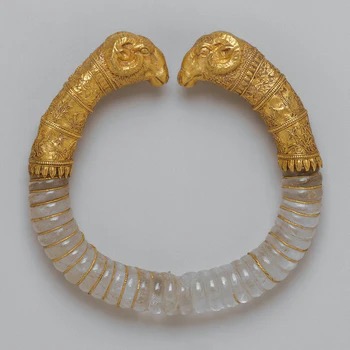The casting process in jewellery making.
- Katie Woollett
- Oct 11, 2024
- 3 min read
The cultures most commonly associated with lost wax casting are ancient Greece and Rome. Their bronze statues are some of the most admired works of art in history. However,
the earliest examples of lost wax casting were found in Mesopotamia, at the Varna burial site in what is now Bulgaria, and date to 6,500 years ago. (Image 1).The artifacts include beads, bracelets, and other small items. While Mesopotamia and the surrounding areas are recognised for their sophisticated metal artifacts, ancient cultures in other parts of the world, also employed lost wax casting methods.
Around 500 BC, Greek artists crafted bronze statues using the direct method. This required creating a model of the final statue out of wax. A mold was placed around the wax and fired, which melted the wax. Molten bronze was poured inside the mold and allowed to harden. However this meant that, while a great degree of detail could be achieved, the statue was created in solid metal, and the statue could not be replicated.
To resolve these issues, the Greeks utilized the indirect lost wax casting method for most of their later sculptures (Image 3).This process created hollow statues and models could be reused again and again. The indirect method involved coating a clay model with wax, then covering that layer with more clay. The whole piece was heated to remove the wax between the clay layers. Molten metal was poured into the cavity left behind and once cooled, was broken to reveal the finished statue.
Much of the jewelry in Ancient Greece, the Hellenistic Period specifically (c. 323 BCE–31 BCE), was made of gold. Gold was used before but became especially popular after Alexander the Great’s conquest of the Persian Empire which resulted in more intense trade in this stock in the Hellenistic world.Many different types of jewelry existed during this time: hair ornaments, thigh- and armbands, earrings, rings, pins and pendants, and necklaces. Besides gold, gemstones, semi-precious stones, and pearls often decorated the ornamental pieces. (image 2).
The Dunaverney (image 3) and Little Thetford flesh hooks are ancient tools that were crafted using lost wax casting. They were found in Ireland and England, respectively, and date to approximately 1000 BC.
Modern jewellery is primarily made in one of two ways. The piece is either forged from metal, either sheet or wire or it is cast. If it is cast, it can be a one off piece, or a mould can be made so that the pieces can be repeated. Then a mould can be made from a wax model, or it can be made from a metal prototype by adding a spru to the metal. A spru is the channel through which the molten metal can be poured to recreate the original form.
The perfected pattern is encased in a material that can withstand high temperatures. Traditionally, plaster and refractory materials were used, but nowadays, silicone rubber or investment casting materials are popular due to their precision. The mold is carefully created around the pattern, capturing every detail of its surface. The mold undergoes a pre-casting step called the burnout phase , where it’s heated to a high temperature. This melts or evaporates the pattern, leaving behind a cavity perfectly shaped for the molten metal. .With the mold ready, the jewellery designer pours molten metal (usually gold, silver, platinum, or other precious alloys) into it through the spru. The metal fills the mold, capturing the intricacies of the original pattern. (In practice, many designers will send their prototypes to casting company, where they will have the most up to date casting techniques and machinery).
These are all caste pieces, with a wax prototype sent to the caster with a request for a mould to be made so that pieces can be repeated. These pieces were all created by pouring fine streams of molten wax into water. Thus they are shapes that would be be impossible to create directly in silver. I love the resulting organic flow of these pieces of jewellery.
For these rings, I made the base in wax so that different pieces could be added to the top of the base shape, once cast in silver.The value of using wax is that it is easy to carve and shape to the desired finish, and it is inexpensive, which means a designer can experiment until happy with the prototype.


















Comments